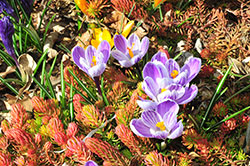Loni Gaudet
Colorado State University Extension Master Gardener in Larimer County
August 29, 2015

As we head into fall, we think about our late season garden chores – cleaning up, mulching, gathering seeds and maybe setting up cold frames for winter veggies. But fall bulb planting is an easy way to jump-start the spring gardening season. At most elevations, the best time to plant bulbs is mid-September to late October, so bulbs can establish roots before the soil freezes.
Purchase bulbs in early September for best selection and variety. Choose bulbs that are large and free from disease or decay. To ensure higher quality, pick out bulbs individually. Consider the flowering time and period when choosing bulbs. Select a variety of bulbs that will provide a long-lasting show in spring. Many suppliers will indicate the bloom time (early, mid or late) and mature height.
Generally speaking, crocus, snowdrops, species tulips, dwarf iris and Siberian squill are very early bloomers. Next are grape hyacinths, tulips, daffodils, fritillaria and common hyacinths. Late spring to early summer bloomers include alliums, bearded iris, and Dutch iris. Careful planning can lead to an outstanding bloom display from early March through early June.
In addition to planting spring blooming bulbs, consider fall blooming bulbs to round out your garden. There are several varieties of fall-blooming crocus. There are more than a dozen species of crocuses that bloom in fall and winter. Another lovely fall bloomer is Colchicum. Colchicums are similar to crocus, but they have broad leaves that grow briefly in the spring and die by midsummer. In the fall, leafless flower stalks produce clusters of large purple flowers. (Do not confuse these with the edible saffron crocus as most parts of the Colchicum plant are poisonous.)
Choose a well-drained location for planting to reduce the risk of the bulbs rotting. In general, plant bulbs at a depth of three to four times the length of the bulb. If planting in sandy soil, plant two inches deeper. Consider having a soil test done before planting to determine if the soil needs any amendments.
Many bulbs naturalize, meaning they will multiply and spread over the years with little effort on your part. Bulbs can also be lovely tucked into little spots in flower beds, in lawns or meadows, around trees or even in rock gardens to add a splash of color in the spring.
Bulbs do well in both sun and shade, but be careful of hot, south exposures where the soil can warm up too early in the spring, and the bulbs may emerge only to be killed back by freezing weather. South exposures also tend to dry over the winter resulting in poor bulb performance. Mulch, such as wood chips applied several inches deep after planting, will help. Mulches insulate and keep the ground from warming up too quickly in the spring. Mulches also conserve moisture and prevent excessive weed growth. After planting, water the bulbs in well to help with rooting. The mulch will help keep the soil moist, so be careful not to overwater.
After the plants bloom in the spring, let the foliage die down naturally. The foliage is used by the bulb to provide energy through photosynthesis for next season’s bloom. Because fading bulb foliage is often unattractive, consider planting annuals or tall groundcovers near the bulbs to hide the foliage as it fades.
Note: The attached photos were taken by Fred McClanahan, Jr. of crocus in spring.
The author has received training through Colorado State University Extension’s Master Gardener program and is a Master Gardener volunteer for Larimer County.
——————-
Larimer County is a county-based outreach of Colorado State University Extension providing information you can trust to deal with current issues in agriculture, horticulture, nutrition and food safety, 4-H, small acreage, money management and parenting. For more information about CSU Extension in Larimer County, call (970) 498-6000 or visit www.larimer.org/ext
——————-
Looking for additional gardening information? Check out the CSU Extension Horticulture Agent blog at www.csuhort.blogspot.com for timely updates about gardening around the state.
——————-
Visit PlantTalk Colorado ™ for fast answers to your gardening questions! www.planttalk.org PlantTalk is a cooperation between Colorado State University Extension, GreenCo and Denver Botanic Gardens.





